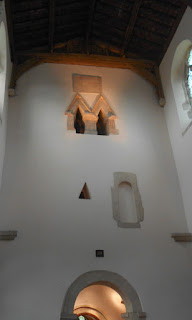Nowadays Deerhurst is a tiny village and it seems hard to imagine that it was here in 1016 that Edmund Ironside and Canute signed the treaty which saw them cease fighting and agree the division of land in the North and South between them. Mysteriously Ironside died shortly afterwards and his share passed over to the Viking making him the first King to rule over the whole of England since the Romans. From the Norman conquest onwards Deerhurst began to lose its power and gradually slide into obscurity. However, it doesn't take much of a leap of imagination to see how it might all have once been....the signs are still there.
The more than substantially sized St Mary's church might just be classed as a parish church nowadays, but it started out life as a priory church and formed part of the larger Benedictine priory site [ the attached house is the priory farmhouse] which was in place by AD 804. Over time the lands were divided up and reallocated until the whole lot was dissolved in 1540. What we're left with is the most complete Saxon church in the country. It is a marvel of strange beasts and carvings which incredibly predate the Romanesque gems I usually vaunt on here.
This one is known simply as the Deerhurst Angel. She sits up high on the exterior of the church, but she started her life on the inside of the original Saxon apse. Now all you have left of it is a semicircular line of ground level stone work which picks out where it once stood.
As you go through the main door you are greeted by these beast label stops on either side of the entrance. Those are quite large fangs they've got whatever they are and the traces of red show that they were once painted. To me they look quite canine like, but the general view is that they are dragons. To my eyes the carvings on either side of the chancel arch look far more dragonesque. Whichever version is correct or not, what we do know is that supposedly there was a Deerhurst dragon which enjoys terrorising the locals and snacking on their cattle. In a bid to stop the rapicious creature the King put up a reward for whoever killed it. One John Smith stepped forward and by leaving milk where he knew the brute would drink it he took advantage of its resulting drowsiness and hacked off its head with his axe. Apparently he was given land for his derring do.












That was really interesting. I lived in East Sussex on and off for about a year when I first arrived and have to say that I was fascinated by the churches and their history. The more you look the more you see!
ReplyDeleteI am so glad that you notice the details and then photograph them for all of us!
ReplyDelete